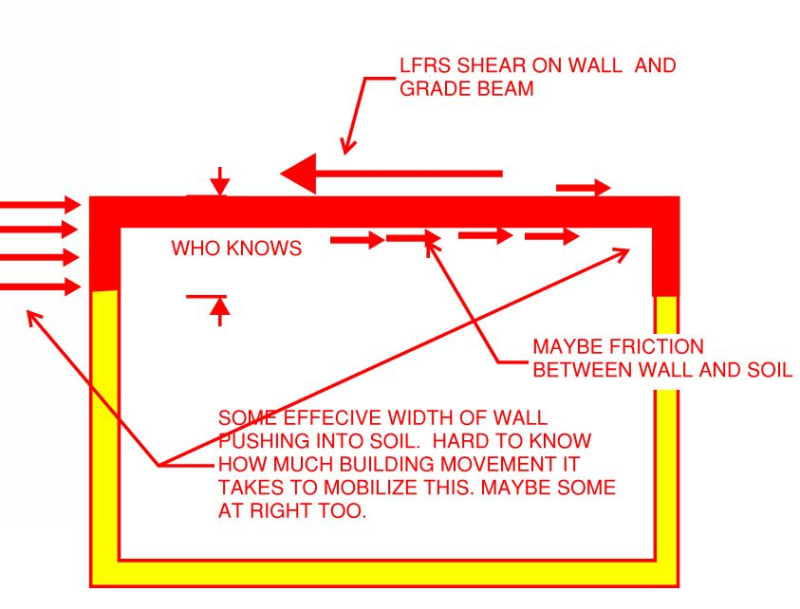sebas-1024
Structural
Hi,
I'm currently responsible for the design of a manufactured home foundation, the client wants to have it supported by a perimeter grade beam which at the same time is supported by piles. I'm having a hard time coming up with a way to confidently analyze the foundation system due to several factors (bear with me as I'm not experienced at all when it comes to manufactured homes supported by grade beams on top of helical piles):
1. The home is comprised of basically 4 shear walls that transmit all of the loads to the foundation system, this means that wind and seismic loads act in an orthogonal direction to the grade beams, this induces torsion on the grade beams and I can't seem to find anything on torsion analysis for grade beams. On the other hand, I was thinking that an acceptable approach could be to have each beam resist the vertical loading of the shear wall on top of it but resist the lateral loads of the shear walls that are perpendicular to it, this would lead me to ignoring any torsional effects and go about a simpler design for it. I'm not positive on the latter though, is that a logical assumption at all to make in this case? (see attached sketch).
2. The idea of having a perimeter grade beam is to eliminate any lateral loading and moments from acting on top of the piles, the initial idea was to brace the piles with a cross bracing system but the client decided against it as they feel that it won't pass local jurisdiction (California doesn't seem to like non-concrete foundations). I'm assuming that, similar to isolated footings, a grade beam can be expected to absorb these loads without transmitting them to the piles, therefore having the piles only resist the vertical loading. Is this approach a correct interpretation of the load path for this foundation system? Or will the piles still receive any moments an lateral loads that go through the grade beams?
3. The connection bracket for the pile needs to be designed obviously, but the documents that I currently have regarding our manufacturer don't go over that part of the design, they only show a few tabulated capacities that may or may not work for me depending on what's determined above regarding the lateral loading. What I mean is that the lateral capacity according to these tables is below the required strength for lateral loading IF the piles are considered to be receiving these loads(we're looking at 1.27 kips of capacity vs a 2 kips load for the most loaded piles). Who determines which is the correct way of designing such a connection (any standards or publications regarding this)?
I know I'm asking a lot of questions but I want to provide the client with a proper design that can pass local jurisdiction without any problems so I'd appreciate any assistance or comments regarding this. Thanks a lot.
I'm currently responsible for the design of a manufactured home foundation, the client wants to have it supported by a perimeter grade beam which at the same time is supported by piles. I'm having a hard time coming up with a way to confidently analyze the foundation system due to several factors (bear with me as I'm not experienced at all when it comes to manufactured homes supported by grade beams on top of helical piles):
1. The home is comprised of basically 4 shear walls that transmit all of the loads to the foundation system, this means that wind and seismic loads act in an orthogonal direction to the grade beams, this induces torsion on the grade beams and I can't seem to find anything on torsion analysis for grade beams. On the other hand, I was thinking that an acceptable approach could be to have each beam resist the vertical loading of the shear wall on top of it but resist the lateral loads of the shear walls that are perpendicular to it, this would lead me to ignoring any torsional effects and go about a simpler design for it. I'm not positive on the latter though, is that a logical assumption at all to make in this case? (see attached sketch).
2. The idea of having a perimeter grade beam is to eliminate any lateral loading and moments from acting on top of the piles, the initial idea was to brace the piles with a cross bracing system but the client decided against it as they feel that it won't pass local jurisdiction (California doesn't seem to like non-concrete foundations). I'm assuming that, similar to isolated footings, a grade beam can be expected to absorb these loads without transmitting them to the piles, therefore having the piles only resist the vertical loading. Is this approach a correct interpretation of the load path for this foundation system? Or will the piles still receive any moments an lateral loads that go through the grade beams?
3. The connection bracket for the pile needs to be designed obviously, but the documents that I currently have regarding our manufacturer don't go over that part of the design, they only show a few tabulated capacities that may or may not work for me depending on what's determined above regarding the lateral loading. What I mean is that the lateral capacity according to these tables is below the required strength for lateral loading IF the piles are considered to be receiving these loads(we're looking at 1.27 kips of capacity vs a 2 kips load for the most loaded piles). Who determines which is the correct way of designing such a connection (any standards or publications regarding this)?
I know I'm asking a lot of questions but I want to provide the client with a proper design that can pass local jurisdiction without any problems so I'd appreciate any assistance or comments regarding this. Thanks a lot.

